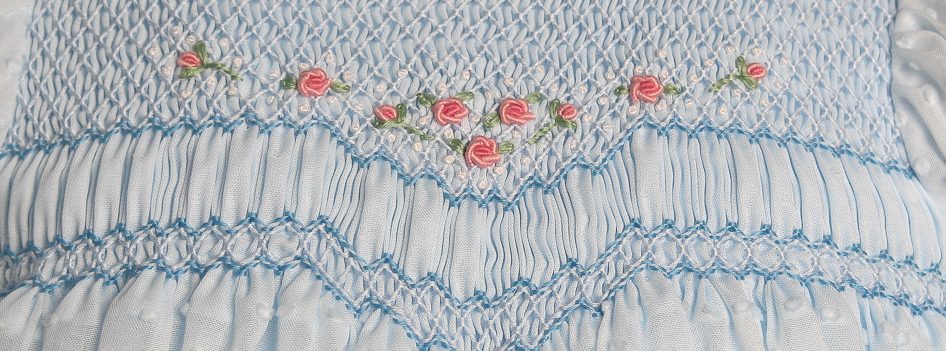This is re-post of a past blog post, with a few additional comments.
Because styles vary from year to year, I wanted to change up the sleeve of the bishop dress so that it was a bit more contemporary. I redrafted the sleeve to the bishop dress pattern from the bishop pattern that I normally use and put the dress together so that I could smock it while on vacation. I always make my bishop dresses as ready-to-smock. Instructions on how to do that are available in my Etsy shop (kathysheirloomshop). I love having a completed dress when the smocking is finished. I was very happy with the end results!

Smocking on prints is always challenging for me, and this was no exception. I took along several different colors of floss as well as several different smocking plates. In the end, I decided to use Creative Keepsake’s “Mackenzie” design. It is similar to the Children’s Corner “Firelight”, which I’ve always loved on prints and plaid fabrics. I think that the use of the 2 colors is very subtle and compliments the print nicely.

The micro check gingham for the bias at the neck and sleeves adds a little brightness to the fall-ish print. The micro check was also used for covered buttons in the back.
Now, for a few details on how the sleeves were redrafted. You’ll notice that they are not smocked. I wanted less full sleeves, so smocking them wasn’t practical as that would require more fullness than I wanted. To reduce the fullness in the sleeves, I creased the sleeve in several places and put some 1/4″ tucks at the creases and pinned them down as seen on the furthest tuck on the right. After I felt that enough fullness was removed, the new sleeve was redrawn with the top edge drawn as a smooth line from one side to the other.

The next thing to do was to reduce the depth under the arm. The finished sleeve depth under the arm is about 1/2″. Then, the final step was to raise the lower edge of the sleeve by drawing a curve (an upside down “U” shape) from one side seam to the other. I didn’t have a particular formula for this, just an educated guess. This is the new sleeve.

After the new sleeve was created, the dress front, sleeves and back were sewn and the bishop dress pleated as normal. However, when the bias band was attached to the dress, the pleats in the front and back of the dress were kept tightly together while the sleeve pleats were spread out. At this point, the pleating threads could be removed from the sleeves and the dress front and back tied off as needed. The short sleeves were gathered at the bottom and bias band was attached. The bias band for the sleeves was adjusted and made slightly longer (measure your child for accurate measurement) since the different shaped opening requires a little more room than the normal smocked sleeve. The remainder of the dress was constructed.
This was a fun dress to make and turned out so cute and was a big hit!!!

If this is something that you want to try, don’t be afraid to experiment!
Happy stitching!
Kathy
